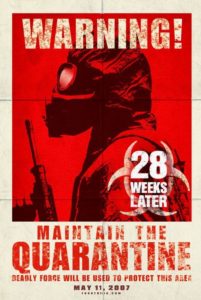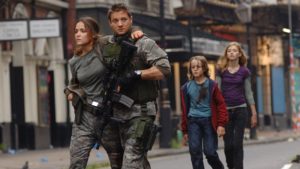Juan Carlos Fresnadillo’s 28 WEEKS LATER (2007) opens on the heterochromatic eyes of Alice (Catherine McCormack) as she strikes a match in a pitch-black room. They fall directly onto us. This framing is purposeful, asserting an omnipresent judgement. In the midst of the first rage virus outbreak, Alice and her husband Don (Robert Carlyle) join a small group of survivors for dinner. A sudden knock on the door ironically disrupts a heated conversation about what separates “us” from “them.” The question about letting the panicked child inside is heavily debated. For Alice, who is uncertain whether and when she will see her children again, the choice is simple.
Following the child’s introduction, the house is swarmed by the infected. The tension of this scene is frenetic. Its grainy, underexposed photography nonetheless renders each attack vivid. The last we see of Alice, for the moment, is her petrified face in a window after Don shuts a door on her and the child to save himself. Before she is pulled into the abyss behind her, Alice’s searing glance burns a hole through the celluloid. Running for his life, Don manages to fend off a horde of infected pouring in from the hills in the periphery. He escapes but is never free from the torment of leaving his wife behind.
With its opening sequence, Fresnadillo steadfastly lays down the central concerns of his film. The infected trailed behind the boy who was taken in as a refugee, but the initial outbreak and the lack of an efficient response to control its spread are not his fault. Nor is Alice’s act of mercy condemnable. The ensuing narrative further challenges prejudice against the individual for the failures of a governing body. It also presents the unavoidable dangers of relinquished freedoms under the pretense of safety.

Danny Boyle and Alex Garland’s 28 DAYS LATER (2002) is a solemn portrait of the mundanity we take for granted succumbing to a violent disease. A harrowing realization that the most evil parts of society (embodied by hyper-militarism and fueled by elite panic) exist to sustain themselves by tearing a future away from the rest of us. Ultimately, it solidifies the good nature of people working together to rebuild in a post-apocalyptic scenario.
Boyle’s direction is instrumental to establishing a palpable disaster from which humanity rises in defiance of oppressive social programming. Fresnadillo opens the concept of an England under siege to the terrifying new implications of world powers ensnared by draconian measures of national security. Where Boyle affirms the perseverance of collective action in the face of struggle, Fresnadillo delivers a grim warning against complacency.
In 28 WEEKS LATER, the main focus of the story is Don’s children, for whom he arranges entry into the designated “safe zone” of District One using his privilege as caretaker. As Tammy (Imogen Poots) and Andy (Mackintosh Muggleton) arrive for biometric processing the scene evokes a complicated political reality. They are white British citizens, but their new status as refugees alienates them from the country they once called home. And the flaws in their new residence are menacingly pronounced.
The US army provides shelter in District One at a cost that runs contrary to the interests of a truly free society. Yet, the unnerving way people have adapted to life in the heavily armed and surveilled zone is a deliberate subversion on the part of the filmmakers. Often in zombie films, survivors pull resources to recreate a semblance of normality in the broken spaces around them. In the district high rises, every person is viewed as a liability under the gaze of cameras and restless snipers. Unlike the ease with which the found family unit in 28 DAYS LATER coalesced, neighborly gestures are all but discouraged here. Each resident is a target first and foremost. The soldiers watching them yearn for combat. When all hell breaks loose, we see this tension build to a nauseatingly horrific conclusion.

As the film introduces the possibility of eradicating the rage virus via hereditary traits in the siblings, there is hardly a chance to savor a hopeful outcome. A permeating sense of doom befalls each frame. The motif of all-seeing eyes recurs throughout, a burden passed down to Andy. When he is not on screen, the chilling gaze is suggested by the film’s cinematography. The siblings find Alice in their old home after they sneak away from the district. Even the brief comfort of finding their mother alive, a counterpoint to Jim’s tragic discovery in the original, is disrupted by the physical and emotional scars of her own survival.
In one of the most eviscerating moments offered by a zombie film, Don shares a fateful kiss with Alice. Having carried the virus asymptomatically, she transmits it to him. She is killed immediately afterwards. Don’s infection sparks a second outbreak which exposes the sinister priorities in the district’s infrastructure. We’ve already seen that the goal of District One was never to keep people safe. It was to accommodate them so that they’d be complacent in their own extermination. This is escalated via a firebombing that ravages everything in its path, forcing a medical officer and a sergeant to protect the siblings at all costs. Including resistance to openly contemptuous directives from powers hellbent on extermination.
The medic and the sergeant perish in cruel, ironic fashion. It’s worth noting that the ever-present motif of surveillance dies a grueling death with the former. Their mission is then passed on to a reluctant helicopter pilot. Which begs the question: is there anywhere on earth the siblings (carriers) would be met with benevolence? In franchise canon, the virus is developed to study the chemical aspects of rage in humans and then continued as a bioweapon. None of this inspires confidence. But we never learn the fate of our protagonists. The film leaves us with images of an abandoned helicopter and a horde rushing towards the Eiffel Tower, suggesting the virus likely becomes global. On first viewing, this is anticlimactic, especially when compared to the finale of its predecessor.
The protagonists of 28 DAYS LATER defy the rigidity of life under passive surveillance with dark humor. Its naturalistic mise en scene is both liberated and made eerily distant by a DV aesthetic. We get a glimpse of life as it exists under the watchful eye of a CCTV camera. Fresnadillo’s film burns it all down and reveals the apathetic chain of command on the other side of the monitor. But the fire in the green zone cannot eradicate the shortcomings of sociopathic leadership. After the credits roll, the spectre of this catastrophe is hauntingly unresolved.
To say 28 WEEKS LATER is pessimistic would likely be underselling the experience. There isn’t even respite in the form of the sublime closing notes of John Murphy’s iconic theme: “In The House–In A Heartbeat.” And there is no writing around the ways this film firmly planted itself in its own time or how it resonates today. But this is a great sequel for how it recontextualizes familiar ideas. Fresnadillo was given the reins to a property which only hinted at the possibilities of what to do with a “diseased little island.” The director ended up making one of a handful of stellar horror projects under the Fox Atomic label to relish in unsubtle, pointed critiques at authority. It is a great film that provokes its viewer with the sincerity of its convictions.


No Comments